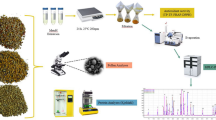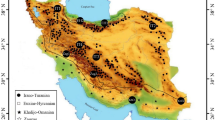Abstract
Characterization of volatile compounds composition and evaluation of antioxidant properties of bee pollen collected in Lithuania is presented in the paper, which is the first study on pollen of Lithuanian origin to our knowledge. Three polyfloral pollen samples collected by honey bees were analyzed. Characterization of volatile compounds was performed using solid phase microextraction (SPME) and GC-MS. Styrene was predominant in all samples contributing 19.6–27.0 mass %. Sample A distinguished by a high amount of limonene, 9.0 mass %, sample B differed from the rest by a high content of hexanal, 9.3 mass %, and nonanal, 12.3 mass %, while sample C showed the highest content of 1-tridecene, 43.3 mass %. Screening of antioxidant properties was carried out by spectrophotometric methods and liquid chromatography coupled with a post-column 1,1-diphenyl-2-picrylhydrazyl (DPPH) reaction detector and electrochemical detector. Total phenolic and flavonoid contents together with radical scavenging activity in the free radical (DPPH) model system were evaluated in the tested samples. Total phenolic content varied from 24.4 mg g−1 to 38.9 mg g−1, total flavonoid content was in the range of 7.3–10.0 mg g−1 and radical scavenging activity was found between 30.7 mg g−1 and 34.9 mg g−1, all data are expressed in rutin equivalents. To process the collected data statistically and classify the bee pollen samples to clusters according to their volatile composition and antioxidant activity, principal component analysis, hierarchical cluster analysis and non-linear discriminant analysis were applied.
Similar content being viewed by others
References
Aaby, K., Hvattum, E., & Skrede, G. (2004) Analysis of flavonoids and other phenolic compounds using high-performance liquid chromatography with coulometric array detection: Relationship to antioxidant activity. Journal of Agricultural and Food Chemistry, 52, 4595–4603. DOI: 10.1021/jf0352879.
Campos, M. G. R., Frigerio, C., Lopes, J., & Bogdanov, S. (2010) What is the future of bee-pollen? Journal of ApiProduct and ApiMedical Science, 2, 131–144. DOI: 10.3896/ibra.4.02.4.01.
Carpes, S. T., Mourăo, G. B., de Alencar, S. M., & Masson, M. L. (2009) Chemical composition and free radical scavenging activity of Apis mellifera bee pollen from Southern Brazil. Brazilian Journal of Food Technology, 12, 220–229. DOI: 10.4260/bjft2009800900016.
Čeksterytė, V., Kurtinaitienė, B., & Balžekas, J. (2013) Pollen diversity in honey collected from Lithuania’s protected landscape areas. Proceedings of the Estonian Academy of Sciences, 62, 277–282. DOI: 10.3176/proc.2013.4.08.
Coe, P. (2007) Bee bread in apitherapy. Journal of the American Apitherapy Society, 14, 12–16.
Damašius, J., Venskutonis, P. R., Kaškonienė, V., & Maruška, A. (2014) Fast screening of the main phenolic acids with antioxidant properties in common spices using online HPLC/UV/DPPH radical scavenging assay. Analytical Methods, 6, 2774–2779. DOI: 10.1039/c3ay41703d.
Estevinho, L. M., Rodrigues, S., Pereira, A. P., & Feás, X. (2012a) Portuguese bee pollen: Palynological study, nutritional and microbiological evaluation. International Journal of Food Science & Technology, 47, 429–435. DOI: 10.1111/j.1365-2621.2011.02859.x.
Estevinho, L. M., Feás, X., Seijas, J. A., & Vázquez-Tato, M. P. (2012b) Organic honey from Trás-Os-Montes region (Portugal): Chemical, palynological, microbiological and bioactive compounds characterization. Food and Chemical Toxicology, 50, 258–264. DOI: 10.1016/j.fct.2011.10.034.
Fatrcová-Šramková, K., Nôžková, J., Kačániová, M., Máriássyová, M., Rovná, K., & Stričík, M. (2013) Antioxidant and antimicrobial properties of monofloral bee pollen. Journal of Environmental Science and Health, Part B, 48, 133–138. DOI: 10.1080/03601234.2013.727664.
Feás, X., & Estevinho, M. L. (2011) A survey of the in vitro antifungal activity of heather (Erica sp.) organic honey. Journal of Medicinal Food, 14, 1284–1288. DOI: 10.1089/jmf.2010.0211.
Feás, X., Vázquez-Tato, M. P., Estevinho, L., Seijas, J. A., & Iglesias, A. (2012) Organic bee pollen: Botanical origin, nutritional value, bioactive compounds, antioxidant activity and microbiological quality. Molecules, 17, 8359–8377. DOI: 10.3390/molecules17078359.
Freire, K. R. L., Lins, A. C. S., Dórea, M. C., Santos, F. A. R., Camara, C. A., & Silva, T. M. S. (2012) Palynological origin, phenolic content and antioxidant properties of honeybee-collected pollen from Bahia, Brazil. Molecules, 17, 1652–1664. DOI: 10.3390/molecules17021652.
Geiselhardt, S., Ockenfels, P., & Peschke, K. (2008) 1-Tridecene — male-produced sex pheromone of the tenebrionid beetle Parastizopus transgariepinus. Naturwissenschaften, 95, 247–251. DOI: 10.1007/s00114-007-0312-5.
Graikou, K., Kapeta, S., Aligiannis, N., Sotiroudis, G., Chondrogianni, N., Gonos, E., & Chinou, I. (2011) Chemical analysis of Greek pollen — antioxidant, antimicrobial and proteasome activation properties. Chemistry Central Journal, 5, 33. DOI: 10.1186/1752-153x-5-33.
Hurd, L. (2002) Bee pollen: Top rank antioxidant. Total Health, 24, 40–42.
Jandera, P., Škeříková, V., Řehová, L., Hájek, T., Baldrianová, L., Škopová, G., Kellner V., & Horna, A. (2005) RP-HPLC analysis of phenolic compounds and flavonoids in beverages and plant extracts using a CoulArray detector. Journal of Separation Science, 28, 1005–1022. DOI: 10.1002/jssc.200500003.
Kaškonienė, V., Venskutonis, P. R., & Čeksterytė, V. (2008) Composition of volatile compounds of honey of various floral origin and beebread collected in Lithuania. Food Chemistry, 111, 988–997. DOI: 10.1016/j.foodchem.2008.05.021.
Kaškoniene, V., Maruška, A., Kornyšova, O., Charczun, N., Ligor, M., & Buszewski, B. (2009) Quantitative and qualitative determination of phenolic compounds in honey. Cheminė Technologija, 3, 74–80.
Kaškonienė, V., Venskutonis, P. R., & Čeksterytė, V. (2010) Carbohydrate composition and electrical conductivity of different origin honeys from Lithuania. LWT — Food Science and Technology, 43, 801–807. DOI: 10.1016/j.lwt.2010.01.007.
LeBlanc, B. W., Davis, O. K., Boue, S., DeLucca, A., & Deeby, T. (2009) Antioxidant activity of Sonoran Desert bee pollen. Food Chemistry, 115, 1299–1305. DOI: 10.1016/j.foodchem.2009.01.055.
Leja, M., Mareczek, A., Wyżgolik, G., Klepacz-Baniak, J., & Czekońska, K. (2007) Antioxidative properties of bee pollen in selected plant species. Food Chemistry, 100, 237–240. DOI: 10.1016/j.foodchem.2005.09.047.
Mărghitaş, L. A., Stanciu, O. G., Dezmirean, D. S., Bobiş, O., Popescu, O., Bogdanov, S., & Campos, M. G. (2009) In vitro antioxidant capacity of honeybee-collected pollen of selected floral origin harvested from Romania. Food Chemistry, 115, 878–883. DOI: 10.1016/j.foodchem.2009.01.014.
Morais, M., Moreira, L., Feás, X., & Estevinho, L. M. (2011) Honeybee-collected pollen from five Portuguese Natural Parks: Palynological origin, phenolic content, antioxidant properties and antimicrobial activity. Food and Chemical Toxicology, 49, 1096–1101. DOI: 10.1016/j.fct.2011.01.020.
Negri, G., Teixeira, E. W., Alves, M. L. T. M. F., Moreti, A. C. D. C., Otsuk, I. P., Borguini, R. G., & Salatino, A. (2011) Hydroxycinnamic acid amide derivatives, phenolic compounds and antioxidant activities of extracts of pollen samples from southeast Brazil. Journal of Agricultural and Food Chemistry, 59, 5516–5522. DOI: 10.1021/jf200602k.
Nogueira, C., Iglesias, A., Feás, X., & Estevinho, L. M. (2012) Commercial bee pollen with different geographical origins: A comprehensive approach. International Journal of Molecular Sciences, 13, 11173–11187. DOI: 10.3390/ijms130911173.
Pyo, Y. H., Lee, T. C., Logendra, L., & Rosen, R. T. (2004) Antioxidant activity and phenolic compounds of Swiss chard (Beta vulgaris subspecies cycla) extracts. Food Chemistry, 85, 19–26. DOI: 10.1016/s0308-8146(03)00294-2.
Šarić, A., Balog, T., Sobočanec, S., Kušić, B., Šverko, V., Rusak, G., Likić, S., Bubalo, D., Pinto, B., Reali, D., & Marotti, T. (2009) Antioxidant effects of flavonoid from Croatian Cystus incanus L. rich bee pollen. Food and Chemical Toxicology, 47, 547–554. DOI: 10.1016/j.fct.2008.12.007.
Schwarz, K. J., Boitz, L. I., & Methner, F. J. (2012) Enzymatic formation of styrene during wheat beer fermentation is dependent on pitching rate and cinnamic acid content. Journal of the Institute of Brewing, 118, 280–284. DOI: 10.1002/jib.41.
Sharma, O. P., & Bhat, T. K. (2009) DPPH antioxidant assay revisited. Food Chemistry, 113, 1202–1205. DOI: 10.1016/j.foodchem.2008.08.008.
Sochor, J., Dobes, J., Krystofova, O., Ruttkay-Nedecky, B., Babula, P., Pohanka, M., Jurikova T., Zitka O., Adam V., Klejdus, B., & Kizek, R. (2013) Electrochemistry as a tool for studying antioxidant properties. International Journal of Electrochemical Science, 8, 8464–8489.
Špánik, I., Janáčová, A., Šusterová, Z., Jakubík, T., Jánošková, N., Novák, P., & Chlebo, R. (2013) Characterisation of VOC composition of Slovak monofloral honeys by GC×GC-TOF-MS. Chemical Papers, 67, 127–134. DOI: 10.2478/s11696-012-0254-z.
Stankevičius, M., Akuņeca, I., Jãkobsone, I., & Maruška, A. (2011) Comparative analysis of radical scavenging and antioxidant activity of phenolic compounds present in everyday use spice plants by means of spectrophotometric and chromatographic methods. Journal of Separation Science, 34, 1261–1267. DOI: 10.1002/jssc.201000915.
Steele, D. H., Thornburg, M. J., Stanley, J. S., Miller, R. R., Brooke, R., Cushman, J. R., & Cruzan, G. (1994) Determination of styrene in selected foods. Journal of Agricultural and Food Chemistry, 42, 1661–1665. DOI: 10.1021/jf00044a015.
Vanbeneden, N., Delvaux, F., & Delvaux, F. R. (2006) Determination of hydroxycinnamic acids and volatile phenols in wort and beer by isocratic high-performance liquid chromatography using electrochemical detection. Journal of Chromatography A, 1136, 237–242. DOI: 10.1016/j.chroma.2006.11.001.
Wolfe, D. (2009) Superfoods: The food and medicine of the future (pp. 342). Berkley, CA, USA: North Atlantic Books.
Wu, C. H., Murthy, H. N., Hahn, E. J., & Paek, K. Y. (2007) Improved production of caffeic acid deratives in suspension cultures of Echinacea purpurea by medium replenishment strategy. Archives of Pharmaceutical Research, 30, 945–949. DOI: 10.1007/bf02993961.
Author information
Authors and Affiliations
Corresponding author
Rights and permissions
About this article
Cite this article
Kaškonienė, V., Kaškonas, P. & Maruška, A. Volatile compounds composition and antioxidant activity of bee pollen collected in Lithuania. Chem. Pap. 69, 291–299 (2015). https://doi.org/10.1515/chempap-2015-0033
Received:
Revised:
Accepted:
Published:
Issue Date:
DOI: https://doi.org/10.1515/chempap-2015-0033




